
Moscow is a city in northern Idaho along the state border with Washington, with a population of 23,800 at the 2010 census. The county seat and largest city of Latah County, Moscow is the home of the University of Idaho, the state's land-grant institution and primary research university.

Latah County is a county located in the north central region of the U.S. state of Idaho. As of the 2010 census, the population was 37,244. The county seat and largest city is Moscow, the home of the University of Idaho, the state's flagship until 2012 and land-grant university.

Bovill is a city in Latah County, Idaho, United States. The population was 260 at the 2010 census, down from 305 in 2000.
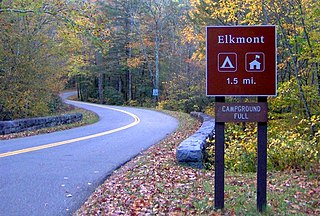
Elkmont is a region situated in the upper Little River Valley of the Great Smoky Mountains of Sevier County, in the U.S. state of Tennessee. Throughout its history, the valley has been home to a pioneer Appalachian community, a logging town, and a resort community. Today, Elkmont is home to a large campground, ranger station, and historic district maintained by the Great Smoky Mountains National Park.

The Lake McDonald Lodge Historic District is a historic district in Glacier National Park in the U.S. state of Montana. It comprises the Lake McDonald Lodge and surrounding structures on the shores of Lake McDonald. It is centered on the main lodge, which was designated a National Historic Landmark in 1987, as well as surrounding guest cabins, dormitory buildings, employee residences, utility buildings, and retail structures. The district includes several privately owned inholding structures that are contributing structures, as well as a number of non-contributing buildings.

Cordelia Lutheran Church was dedicated by Pastor Peter Carlson on December 15, 1883, and is the oldest Lutheran building in the state of Idaho. The church was built on property given by Andrew Olson in the Lenville, Idaho area to serve the Swedish Lutheran families in the area. In 1919, the building ceased to be used for regular church services. The building and surrounding 31 acres (13 ha) is currently owned and administered by a non-profit group named Friends of Cordelia. The building is used for weddings, picnics, socials, concerts and Easter Sunrise service by area residents.

Bryce Canyon Lodge is a lodging facility in Bryce Canyon National Park, Utah, United States, built between 1924 and 1925 using local materials. Designed by architect Gilbert Stanley Underwood, the lodge is an excellent example of National Park Service rustic design, and the only remaining completely original structure that Underwood designed for Bryce Canyon National Park, Zion National Park, and the North Rim of the Grand Canyon.

Moran is an unincorporated community in south central Teton County, Wyoming, United States, which serves as one of the principal fee collection entrances to Grand Teton National Park. It lies in Grand Teton National Park northeast of the city of Jackson, the county seat of Teton County, at the intersection of U.S. Routes 26, 89, 191 and 287. Its elevation is 6,749 feet (2,057 m). As the community has had two different names, the Board on Geographic Names officially ruled in favor of "Moran" in 1970. Although Moran is unincorporated, it has a post office, with the ZIP code of 83013.

The Roosevelt Lodge Historic District comprises the area around the Roosevelt Lodge in the northern part of Yellowstone National Park, near Tower Junction. The district includes 143 buildings ranging in size from cabins to the Lodge, built beginning in 1919. The Lodge was first conceived as a field laboratory for students and educators conducting research in the park. It later became a camp for tourists, specifically designed to accommodate automobile-borne tourists. The Lodge is a simplified version of the National Park Service Rustic style.
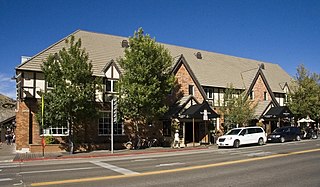
The Wort Hotel was built in downtown Jackson, Wyoming, United States by brothers John and Jess Wort, who were significant figures in the transformation of the economy of Jackson Hole from ranching to tourism. The somewhat Tudor-style building was the first luxury hotel in Jackson. The two-story building features brick facing, with half-timbering and stucco on the second floor and a series of gables facing the street.
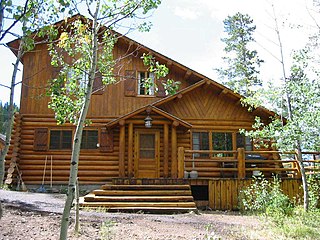
The Brinkerhoff is an historic lodge in Grand Teton National Park on the shore of Jackson Lake. It is the last remaining example of a forest lease vacation lodge in the park. The log house and caretaker's lodge were designed by architect Jan Wilking of Casper, Wyoming and were built in 1946 in what was then U.S. Forest Service land for the Brinkerhoff family. After the creation of Grand Teton National Park, the National Park Service acquired the property and used it for VIP housing. Among the guests at the Brinkerhoff were John F. Kennedy and Richard M. Nixon. The lodge is also notable as a post-war adaptation of the rustic style of architecture. The interior is an intact example of this transitional style.

The Swiftcurrent Auto Camp Historic District preserves a portion of the built-up area of Glacier National Park that documents the second phase of tourist development in the park. After the creation of a series of hotels for train-borne visitors including the nearby Many Glacier Hotel, courtesy of the Great Northern Railway's hotel concession, facilities were developed for the increasing numbers of automobile-borne tourists, drawn to Glacier by the Going-to-the-Sun Road. The Swiftcurrent Auto Camp at Swiftcurrent Lake was created for these new tourists. It includes a rustic general store, built in 1935 by the Glacier Park Hotel Company, surrounded by a number of log tourist cabins., as well as a shower and laundry house and other supporting structures.
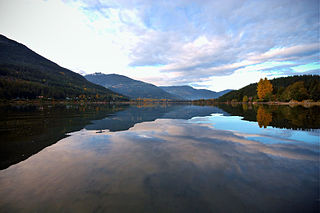
Rainbow Lodge was a small railway resort and was the first commercial fishing and weekend retreat cabin on Alta Lake, which is now part of the Resort Municipality of Whistler, British Columbia, and stood from 1914 to 1977. The lodge was a log cabin with peaked roof on the northwest verge of the lake by the railway line. Railways in North America were keen to capitalize on tourist traffic, hence the Canadian Pacific Railway created Banff National Park in the mountains, and Mont-Tremblant in Quebec; Canadian National built Jasper Park Lodge; UPRR built Sun Valley, Idaho; D & R G built Winter Park in Colorado; Milwaukee Road started Snoqualmie Pass near Seattle. Rainbow Lodge was among the first built along the Pacific Great Eastern line, which as of 1915 opened from Squamish to Clinton, British Columbia and was one of several along the line as far as Lillooet where Craig Lodge was. .

This is a list of the National Register of Historic Places listings in Latah County, Idaho.

The Bovill Opera House in Bovill, Latah County, Idaho is an opera house believed to have been built in the first decade of the 20th century. It is currently listed on the National Register of Historic Places.

The American Legion Cabin on US Alt. 95 in Potlatch, Idaho was constructed in 1928–29. It was listed on the National Register of Historic Places in 1986 because of its historically significant architecture. It was designed as a bungalow with American Craftsman influenceBungalow/Craftsman architecture and served as a clubhouse.
Cornwall is an unincorporated community in Latah County, in the U.S. state of Idaho.
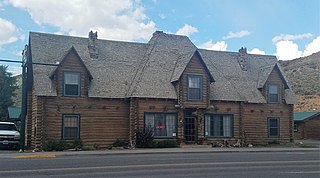
The Twin Pines Lodge and Cabin Camp, also known as the Twin Pines Motel and Frontier Court, is a tourist camp in Dubois, Wyoming on the way to Yellowstone National Park on U.S. Route 287. The camp was established in 1929 by Dubois businessman Oliver Ernest Stringer who designed the camp and assisted in its construction. Stringer had previously been involved in the construction of the Brooks Lake Lodge, where he built furniture.

The Washington, Idaho and Montana Railway is a short-line railroad, described as "a single-track standard gauge steam railroad" that runs between Bovill, Idaho and Palouse, Washington. Construction began in May 1905 by the Potlatch Lumber Company as a logging railroad, but it also carried other freight, passengers, and mail. By the end of that year, 20 miles of track had been laid, and by the end of 1906, the track reached Bovill.

Foster's Log Cabin Court is located at 330-332 Weaverville Road in Woodfin, North Carolina, about five miles north of the City of Asheville. One of the first auto-oriented tourism facilities in the Asheville area, it features a number of one and two bedroom Rustic Revival log cabins and a dining lodge. It was placed on the National Register of Historic Places in 2017.



















